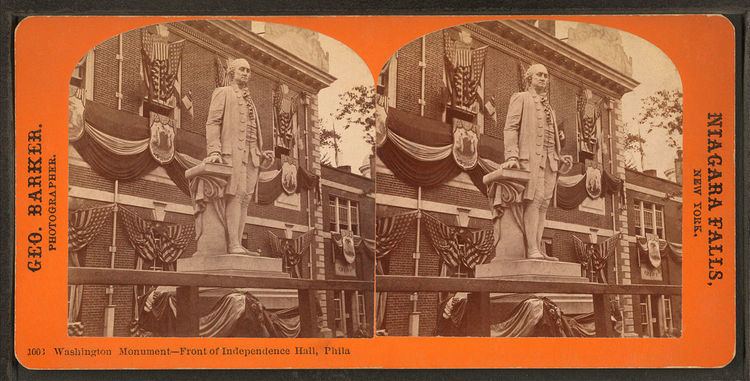Name Joseph Bailly | Died 1883 | |
 | ||
Joseph Alexis Bailly (January 21, 1823 or 1825, Paris, France – June 15, 1883, Philadelphia, Pennsylvania) was a French-born American sculptor who spent most of his career in Philadelphia, Pennsylvania. He taught briefly at the Pennsylvania Academy of the Fine Arts, which has a collection of his sculpture. His most famous work is the statue of George Washington in front of Independence Hall.
Contents
Biography
The son of a Parisian cabinetmaker, Bailly attended the École des Beaux-Arts before being drafted into the Army during the Revolution of 1848. He assaulted an officer, deserted, and fled to England where he studied briefly under the sculptor Edward Hodges Baily (a relation?). After traveling to the United States and Argentina, he settled in Philadelphia in 1850.
Bailly worked as a furniture carver before establishing a sculpture studio with Charles Buschor in 1854. Their first major commission was for the interior ornament and furniture of the New Masonic Hall at 713-21 Chestnut Street in Philadelphia (1855, burned 1886). This included 5 life-sized wood statues illustrating the female Masonic virtues. (The statues and furniture were moved to the current Philadelphia Masonic Temple at Broad & Filbert Streets, when it opened in 1873.) That was followed by the commission for the interior ornament of Philadelphia's opera house, the Academy of Music (1855–57).
At the U.S. Capitol, Bailly designed the Monumental Clock for the United States House of Representatives Chamber (1858) and carved its wooden case. Sculptor William Henry Rinehart designed the flanking bronze figures of the Backwoodsman and the Indian. Furniture makers Bembe & Kimbel manufactured the clock, and gilded the whole piece. It was removed from the House Chamber in 1950, and is now on display in the Capitol's Crypt.
One of his most accomplished works is the marble sculpture group Paradise Lost (1863–68), depicting Adam and Eve ruminating on their expulsion from the Garden of Eden. Its companion piece, First Prayer (1864–68), shows Eve teaching their small children, Cain and Abel. Both works were commissioned by Henry C. Gibson, and are at the Pennsylvania Academy of the Fine Arts.
His giant bronze of Benjamin Franklin (1868) was installed on the corner of the Public Ledger Building's facade and, 250 feet away, his marble statue of George Washington (1869) stood before Independence Hall. Bailly carved a number of funerary memorials, including that of the artist William Emlen Cresson (1869), at Laurel Hill Cemetery, which showed the young painter holding his brush and palette (now missing).
In the 1870s, the United States Mint in Philadelphia commissioned him to carve coin dies for U.S. Trade Dollars — coins with a higher silver content than regular U.S. silver dollars for use in international trade, especially with China, Japan and Korea. The surviving coin dies are unsigned, but design and/or carving of at least three of them are attributed to Bailly.
He exhibited at the Pennsylvania Academy of the Fine Arts beginning in 1851, was elected an Academician by PAFA in 1860, and taught there during the American Civil War. Hired to teach at PAFA in 1876, he resigned two years later in a salary dispute, and Thomas Eakins took over his modeling class.
Among his students were Howard Roberts, John J. Boyle, and Alexander Milne Calder (whose submission for the colossal statue of William Penn atop Philadelphia City Hall was selected over Bailly's). He exhibited several works at the 1876 Centennial Exposition, including the plaster model for an equestrian statue of Venezuela's president, Antonio Guzmán Blanco.
Bailly died in Philadelphia in 1883.
